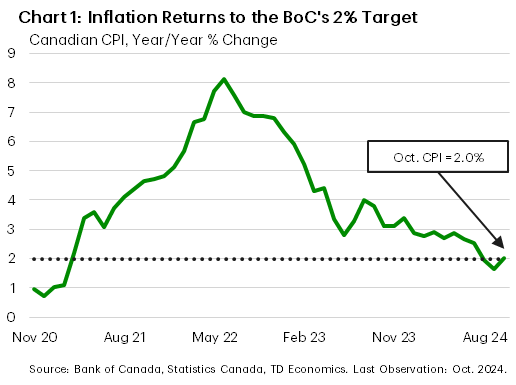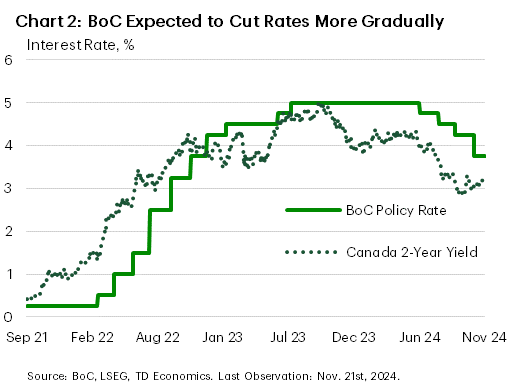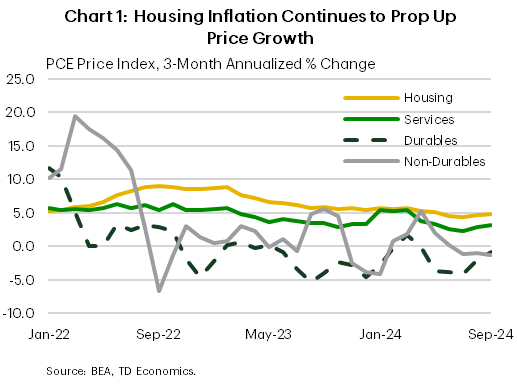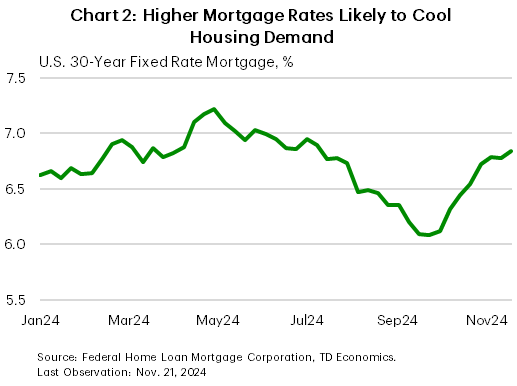Canadian Highlights
- Canadian inflation made headlines this week, with both overall and core inflation pushing higher in October.
- The Canadian consumer was also in the spotlight as retail sales surged and the Federal government announced big stimulus measures to further support spending.
- Rising inflation and stronger consumer spending have raised odds that the BoC will revert to a 25 bp cut when it meets in December.
U.S. Highlights
- A quiet week for data with the housing market showing healthy sales activity and Fed speakers recommitting to a data-dependent approach to policy.
- The focus will be on housing inflation in next week’s Personal Income and Outlays report for October.
- Productivity growth has allowed inflation to cool without sacrificing much growth. Whether that continues through the end of 2024 and into 2025 will be material for Fed policy.
Canada – Inflation Can’t ‘Shake it Off’
Taylor Swift may still be in Toronto, but it was the steady stream of economic data that dominated headlines this week. Canadian Consumer Price Index (CPI) inflation was supposed to be the star with a big upwards move in October (Chart 1), but the Federal government’s large pre-election stimulus to support consumer spending took center stage. Retail sales data for September also came in hot, showing that Canadian consumers may have entered a new ‘Era’ of elevated spending. Housing starts data also showed strength in October, likely reacting to the revival happening in the resale market. Financial markets responded by pricing a greater likelihood that the Bank of Canada (BoC) will revert to cutting by 25 bps at its December meeting.
A more gradual pace of interest rate cuts is consistent with October’s inflation data, which was a bit hotter than expected, bouncing back to target after a soft reading in September. And it wasn’t just higher gasoline prices behind the increase. The BoC’s core inflation measures also rose two tenths to 2.6% y/y on average, above the 2.5% mark the Bank had flagged in the past as behind the reason they were comfortable making a larger 50 basis point cut. This reminded markets that the BoC is not ‘Out of the Woods’ when it comes to controlling inflation.
Stronger consumer demand may be the source of rising inflation. After a long period of cautious spending, consumers are feeling ‘22’ again. It looks like the effect of lower rates is finally starting to raise sentiment. Retail sales data released Friday confirmed this, with a near 1% monthly jump in September and the advanced estimate for October showing more of the same. And this isn’t even including the rampant spending seen in Toronto over the last two weeks, where a flood of Swifties descended on the city to scoop up $100 shirts and T-Swift themed cocktails at local bars. The Federal government’s huge pre-election stimulus is likely to extend this spending spree through the first half of 2025, as the HST break and a round of $250 cheques will pull spending forward and boost overall GDP growth.
A stronger Canadian consumer also means that housing is back in ‘Style’. Lower rates have sparked the housing market, with resale activity and prices showing renewed strength ever since the BoC cut by 50 bps in October. This has parleyed into improved builder confidence, as housing starts data showed an impressive 8% monthly increase in October. This implies that residential investment should start being a positive contributor to Canadian GDP growth following three years of this sector dragging down growth.
If there was one T-Swift song that would characterize what the BoC should do, it’s: ‘You Need to Calm Down’ – with the pace of rate cuts that is. Everyone remembers the central bank electing to cut by an oversized 50 bps back in October. At the time, we made our own headlines by saying how this wasn’t needed and that it risked sparking the real estate market. This was the right advice, as the bank is looking increasingly likely to revert to its prior pace of 25 bps cuts. This may make it the ‘Anti-hero’ for those hoping for a Swifter pace of cuts, but it is likely the best course of action given the state of the economy.
U.S. – Looking Ahead After a Quiet Week
A brief rally in Treasuries fizzled out this week and, at the time of writing, Treasury yields are roughly back to where they were at Monday’s open. Ultimately, a pair of housing reports coming in roughly in line with expectations and two Fed speakers emphasizing data dependence, leave us looking to next week’s Personal Income and Outlays report as the next sign-post to gauge where the Fed’s rate cutting campaign is headed.
Two Fed Board Members took the stage this week – Governor’s Bowman and Cook. Though they offered slightly different interpretations of the state of the economy both recommitted to a data-dependent approach to rate setting. Governor Cook presented her view of the outlook, with an emphasis that the disinflation process is well on its way “even if the path is occasionally bumpy”. Governor Bowman was more pessimistic noting that, “progress on inflation seems to have stalled”. Markets now expect the Fed’s preferred inflation gauge (the personal consumption expenditure index excluding food and energy) to show another strong advanced in October of 0.3% month-on-month (m/m, 3.7% annualized) – well ahead of the Fed’s 2.0% target. Whether it’s a bump or another sign of stalling will come down to the details of the report.
The good news is that the growth in most goods and services prices has moderated significantly (Chart 1). Goods price trends have been a key part of the recent cooling with prices in both durables and nondurables in deflation over the past several months. There is some worry this benefit could be coming to an end as there was a notable uptick in durable goods prices last month (+0.3% m/m). With retail sales demand still healthy, another price gain can’t be ruled out. Adding to the concern is the prospect that tariffs are around the corner. For policymakers, the end of the downdraft from durable goods prices would come at an inopportune time as it has provided a meaningful deflationary offset to a still-hot housing sector.
This puts more focus on what kind of print we can expect in the coming months from the housing market. Sales activity clocked in a healthy gain last month amid lower mortgage rates in late summer. However, this is likely to be a temporary burst as affordability is still stretched, and the recent backup in borrowing costs should dent demand (Chart 2). With inventory levels near balanced territory, this should help temper further price gains.
To date, U.S. consumers have benefited from a productivity boom that has allowed inflation to cool without sacrificing much growth. The key concern now is whether this pace of productivity growth can extend into next year. This means looking at the details in the data for signs that demand growth is yet again outpacing supply. Markets currently judge the odds of a Fed cut in December at a coin toss. An upside surprise next week could make it a long-shot.
















